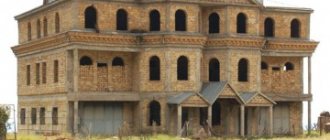How to obtain permits for construction
Step 1. Gather documents:
- application for the provision of public services (filled out online);
- when contacting a proxy: a document certifying the authority of the representative;
- documents of title to the land plot, including an agreement on the establishment of an easement, a decision on the establishment of a public easement, as well as an approved layout of the land plot or land plots on the cadastral plan of the territory on the basis of which the specified land plot was formed and the urban planning plan for the land plot was issued;
- consent of all rights holders of a capital construction project in the event of reconstruction of such a facility;
- a positive conclusion from the examination of the design documentation (in terms of its compliance with a number of requirements) in accordance with which the construction and reconstruction of a capital construction project are carried out, including if this design documentation provides for the construction or reconstruction of other capital construction projects, including linear facilities (in relation to individual stages of construction), if such design documentation is subject to examination (in the absence of the specified information in the integrated automated information system for supporting urban planning activities of the city of Moscow (IAIS OGD) or in the unified state register of expert opinions on design documentation for capital construction projects (USRZ)). If the design documentation is not subject to examination and is not in the IAIS - the results of engineering surveys and materials contained in the design documentation;
- in the case of reconstruction of an apartment building: the decision of the general meeting of owners of premises and parking spaces in the apartment building, and if as a result of such reconstruction there is a decrease in the size of the common property in the apartment building - the consent of all owners of premises and parking spaces in the apartment building;
- a copy of the decision to establish or change a zone with special conditions for the use of the territory in the case of the construction of a capital construction project, in connection with the construction or reconstruction of which a zone with special conditions for the use of the territory is subject to establishment or change;
- confirmation of compliance of changes made to the project documentation with the requirements of the Urban Planning Code, provided by a person who is a member of a self-regulatory organization based on the membership of persons preparing project documentation, and approved by a specialist in the organization of architectural and construction design engaged by this person in accordance with the code in the position of chief engineer of the project , in case of changes to the design documentation;
- confirmation of compliance of changes made to the project documentation with the requirements specified in the Urban Planning Code, provided by the executive authority or organization that carried out the examination of the project documentation, in the event of changes to the project documentation during expert support (in the absence of information in the information systems and resources of the city of Moscow or in the Unified State Register);
- other documents.
If a land plot is formed from lands that are in state or municipal ownership, provided that such lands are not encumbered by the rights of third parties (except for easement, public easement), except for land plots subject to withdrawal for state needs, issuance of a permit construction of such a facility is allowed until the specified land plot is formed. It occurs on the basis of an approved land surveying project and (or) urban planning plan for the land plot and a layout scheme for the land plot in the cadastral plan of the territory approved in accordance with land legislation. In this case, provision of title documents for the land plot is not required to issue a permit for the construction of a capital construction project. Instead of these title documents, the application for a construction permit is accompanied by details of the approved land surveying project or a diagram of the location of the land plot or land plots on the cadastral plan of the territory.
Step 2. Submit documents.
Construction permits are issued by the Moscow State Construction Supervision Committee. An application for a permit must be submitted online on the official website of the Moscow Mayor mos.ru
Is it possible to register ownership of an already built house?
Previously, the procedure for registering a built house was very complicated, requiring a long wait and collecting a lot of documents. To simplify the process of legitimizing buildings and motivate citizens to register ownership of their properties, a dacha amnesty was introduced. The dacha amnesty is a simplified procedure for registering country property. Since its inception, this law has undergone changes several times. Every year, amendments are made to it, which complicate the registration process. At the moment, the State Duma has extended the dacha amnesty until 2021. We strongly recommend that you do not delay registering your property and do it under the dacha amnesty that is still in effect.
Self-construction must be legalized. First, you should contact the administration, providing the necessary package of documents. If you have tried all the possibilities to register your house administratively, you can go to court and resolve the issue in court. Below we will look in more detail at ways to register built houses.
What is considered self-construction
Unauthorized construction projects include:
- Residential and non-residential buildings, capital outbuildings, erected without approval from the administration.
- Real estate reconstructed without approval. Reconstruction includes extensions to buildings, changing the number of storeys, and building a new house on the site of an old one.
- Real estate built on an unregistered land plot Such plots with houses that are not registered in the cadastral register are often inherited from elderly relatives.
In order to avoid sanctions provided for unauthorized construction, such a house must be legalized in order to be fully disposed of.
Consequences of building without permission
Unauthorized construction deprives the owner of the official right to dispose of a residential building and other buildings.
Such real estate cannot be registered in the cadastral register and officially registered with Rosreestr. This means that it will not be possible to sell, donate, rent out the house, or bequeath to heirs; apply for a secured loan; resolve possible legal disputes. If illegal construction is detected, the law provides for fines of 200 thousand rubles; forced demolition of an object at one’s own expense; in some cases - seizure of land. Some owners of unauthorized buildings believe that if they do not need real estate transactions, supervisory authorities will not notice the unauthorized construction, and sanctions will not affect them. It's an illusion. Since August 2021, the authorities of Moscow, the Moscow region and other regions have acquired the authority to identify illegal real estate. Gosstroynadzor commissions regularly carry out raids and conduct inspections. Each inspector is assigned a territory patrolled by quadcopters. Information about self-construction also comes from other sources - local government bodies, requests from individuals and legal entities.
In the Moscow region, any citizen can easily check the legality of a building using a special mobile application - just point the smartphone camera at the object. If information on it does not appear on the screen, there is reason to suspect squatter construction and contact Gosstroynadzor. It is almost impossible to hide the fact of illegal construction.
The key to successfully completing the procedure for recognizing rights is knowledge of the Town Planning Code, land use and development rules. Cadastral engineers and lawyers of the Istrariel Academy of Sciences organize and implement the legalization procedure. To do this, we carry out land surveying, prepare documents for registration - a boundary plan, a technical plan of the house. If required, we will draw up a statement of claim and provide legal support in court. We help legalize unauthorized construction with virtually no refusals.
Registration of a new house built on the site of an old one
Quite often it happens that the owner dismantles the old house and builds a new cottage in its place. At the same time, the old, already virtually destroyed house continues to be registered in the cadastral register, while the newly built building remains unregistered. Naturally, the owner does not have a construction permit in this case.
How to act in such a situation:
- As in the first case, you first need to contact the administration and submit a notification about the start of construction.
- After this, you will need to draw up an inspection report of the property and, on its basis, remove the old building from the cadastral register. The inspection report is drawn up by a cadastral engineer, who enters information about the demolition of the house due to its unsuitability for operational use. You can order this document from the specialists of KB-Real Estate.
- To remove an old house from cadastral registration, you should submit an application to Rosreestr, attaching to it an inspection report created by our cadastral engineer. Only after this will a corresponding entry be made in the real estate register and your old house will be deregistered.
- After this, we return to the first point and look at what response the municipality gave to the construction notice. If the administration’s response is positive, care should be taken to prepare a technical plan. Our cadastral engineer will be able to help you prepare the correct technical plan.
- After this, some time later, a notification of completion of construction and a pre-prepared technical plan should be submitted to the administration.
- After the inspection, if the administration finds no violations, you will be given a document of compliance, and the house will be registered in the cadastral register.
Step-by-step instructions for commissioning an apartment building
The step-by-step process when handing over the structure for use will look like this:
- contacting the BTI to call specialists on site;
- submitting an application to local authorities;
- inspection of housing according to the Unified State Register of Real Estate;
- obtaining a cadastral passport;
- submitting all materials to the specialist dealing with your issue;
- submitting an application to the town planning department;
- submission of all received documentation to the BTI;
- registration of property rights.
Developer actions
Regardless of whether an apartment building is being rented or a private building is being rented out, the developer should:
- complete all construction work according to the project;
- obtain a technical passport and register the object;
- take a separate address;
- obtain documentation confirming the fulfillment of all technical conditions;
- carry out a set of tests.
Input features and required documentation
The use of a building put into use does not occur immediately. First, the developer notifies about the completion of construction work. Then a commission is created to check the construction for compliance with the current requirements. Next, the commission certifies that the development corresponds to the declared project.
The step-by-step instructions state that the developer needs to submit an application and a certain package of materials to the authorized body, including:
- diagram and plan of the allotment;
- papers confirming the legality of the construction;
- act of acceptance of a capital structure;
- documentation on the object’s compliance with standards.
What happens after the commissioning certificate is issued
After issuing the certificate of commissioning of an apartment building, the developer carries out the following actions:
- completes the finishing and landscaping of the area near the building;
- adjusts the operation of equipment;
- prepares documentation for the supply of energy services;
- organizes acceptance of apartments;
- draws up an agreement with the management organization;
- creates a schedule for inspection of apartments.
House registration cost
The cost of legalizing unauthorized construction depends on the area of construction, compliance with urban planning standards, the need for certain approvals, and the number of refusals. Tariffs for some services: surveying - 12,000 rubles; preparation of technical plans for the house - 16,000 rubles; drawing up a statement of claim and support in court - 35,000 rubles. If the court recognizes ownership of an illegal construction site, the copyright holder will be required to pay taxes for the entire period of use of the property, as well as fines and penalties.
When can the house be put into operation?
The commissioning of a residential building into operation is carried out by a specially created commission at the municipality, and in order for this action to take place, it is first necessary to improve the housing structure, that is, to provide residents with all vital communications:
- Water : connection to the central or local (well, borehole) supply.
- Light: installation of electricity transmission lines, connection to them.
- Sewerage: in country houses there is no centralized service, but it is still necessary to arrange a sewage drain that meets sanitary standards.
- Heating: gas, boiler or stove, everyone chooses their own option.
- Convenient access to the home : arrangement of asphalt or gravel roads.
And only when all these facilities are fully ready will it be possible to put the house into operation.
The Supreme Court explained whether it is possible to change the construction time frame
In April 2015, Nadezhda and Nikolai Smirnov* entered into an agreement for shared housing construction with OJSC House Construction Company for 3.3 million rubles. The developer undertook to build the house in the second half of 2015 and transfer the apartments within a month from the date of commissioning. At the same time, the contract stated that the construction time frame could be adjusted within one quarter.
The company did not meet the original deadline and sent shareholders a notice that it was postponing the end of construction to April 2016. As a result, the Smirnovs received an apartment only on April 28, 2016. They decided that the company could not postpone the construction period, so they demanded a penalty for the period from February 1 to April 28, 2016 in the amount of 214,218 rubles. and compensation for moral damage in the amount of 20,000 rubles. The developer objected to this that there were no violations on his part.
Then the shareholders filed a lawsuit, and a fine was added to the claims for refusal to voluntarily pay the penalty. The Oktyabrsky District Court of Belgorod (case No. 2-1091/2019) sided with the developer. The Belgorod Regional Court agreed with him (case No. 33-4363/2019). As indicated by two authorities, the agreement that the parties entered into allows for adjustments to the construction time frame within one quarter.
You can't just change the dates
But the Supreme Court did not agree with the position of the lower authorities and overturned their decisions (case No. 57-KG20-1). The case was sent for a new trial.
The Supreme Court clarified that the condition on the date of transfer of the object is essential. If participants in shared construction accept a proposal from the developer to postpone the deadline, such changes are subject to state registration. The company cannot arbitrarily change the terms of the agreement on its own. An indication in the contract of the company's right to adjust construction dates within one quarter does not change the deadline for handing over the house.
In this case, the civil panel applied clause 4 of the Review of judicial practice in resolving cases on disputes arising in connection with the participation of citizens in the shared construction of apartment buildings and other real estate of the Supreme Court dated July 19, 2021. It directly states that construction periods can only be changed using an additional agreement. “The law does not provide for unilateral amendment of the contract, which means that merely notifying shareholders of a change in terms is not enough. It does not confirm the mutual will of the parties to such a change,” sums up Victoria Veluga, a lawyer at the firm Intellectual Capital Intellectual Capital Federal Rating. group Intellectual property (Protection of rights and litigation) group Intellectual property (Registration) group Arbitration proceedings (medium and small disputes - mid market).
“The developer’s unilateral postponement of the construction and delivery deadlines significantly violates the rights of shareholders, so the courts must stop this,” says Georgy Murzakaev, consultant at O2 Consulting O2 Consulting Federal Rating. group Digital economy group Private capital group Intellectual property (Consulting) group Compliance group Tax consulting and disputes (Tax consulting) group Family and inheritance law TMT group (telecommunications, media and technology) group Corporate law/Mergers and acquisitions (high market) group Financial /Banking Law Company Profile.
* All names have been changed by the editors
- Alina Winter
- Supreme Court of the Russian Federation









